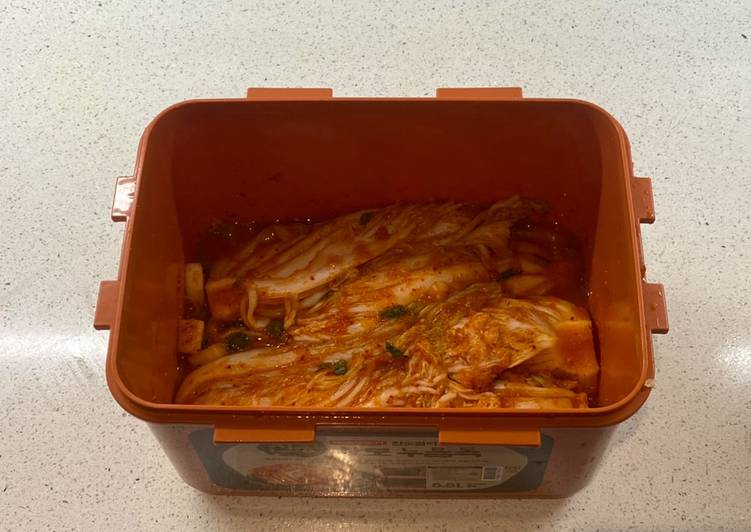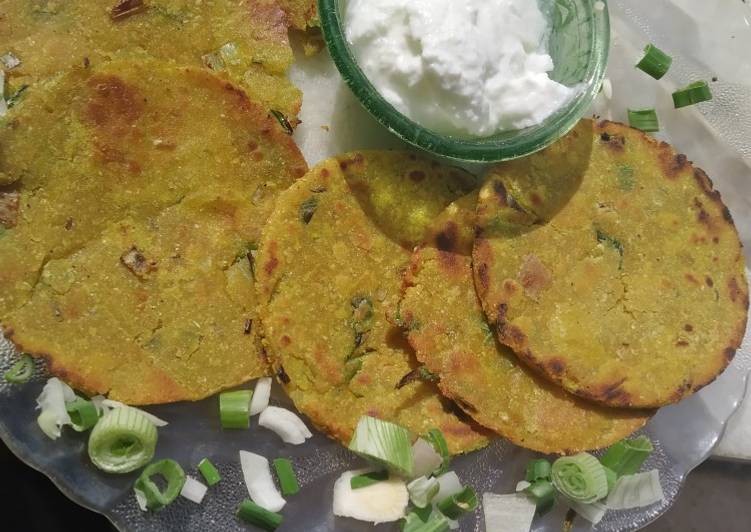
Hey everyone, hope you’re having an amazing day today. Today, I will show you a way to prepare a distinctive dish, kimchi. It is one of my favorites food recipes. For mine, I’m gonna make it a bit unique. This will be really delicious.
Kimchi is one of the most well liked of recent trending meals in the world. It’s appreciated by millions every day. It is simple, it is fast, it tastes delicious. Kimchi is something which I’ve loved my whole life. They are nice and they look fantastic.
Read Customer Reviews & Find Best Sellers. Kimchi (/ ˈ k ɪ m tʃ iː /; Korean: 김치, romanized: gimchi, IPA: ), a staple in Korean cuisine, is a traditional side dish of salted and fermented vegetables, such as napa cabbage and Korean radish, made with a widely varying selection of seasonings including gochugaru (chili powder), spring onions, garlic, ginger, and jeotgal (salted seafood), etc. It is also used in a variety of soups. Mak kimchi, or simple kimchi, is made with cut cabbage, radish, and scallions and a seasoned paste of red pepper, garlic, ginger, sugar, and fish sauce, salted shrimp, or kelp powder. (Image credit: Apartment Therapy ) Kimchi is a fermented dish, the more it ages the better it tastes, likewise with the sugar.
To begin with this particular recipe, we must prepare a few components. You can cook kimchi using 15 ingredients and 13 steps. Here is how you can achieve that.
The ingredients needed to make Kimchi:
- Make ready Salting the cabbage:
- Make ready 3 Chinese cabbages, each cut into half and then into quarters
- Prepare 2-3 cups coarse sea salt
- Prepare Water for rinsing Chinese cabbage
- Take Kimchi paste:
- Make ready 1 brown onion, cut into quarters
- Make ready 5-6 whole cloves garlic (use more or less depending on preference)
- Prepare 1-2 slices ginger (add more or less depending on preference)
- Make ready 2-3 Chinese pear (or use sweet and juicy gala or fuji apples), peeled and cut into chunks
- Prepare 2-3 tablespoons honey or sugar (use more or less depending in preference)
- Make ready 1/4 cup fish sauce (use more or less depending on preference)
- Get 1/4 cup Korean chilli flakes (these flakes are finer, use more or less depending on preference)
- Take 3 tablespoons Gochujang Hot Pepper Paste (use more or less depending on preference)
- Prepare 1/4 cup water (may need to add more water)
- Prepare 4 spring onions finely sliced (to be added into paste at the end)
Kimchi is a true expression of the complexity of umami, that elusive savory fifth taste. It has a well-rounded, tempered heat from fresh ginger, garlic, and gochugaru set off by peppery Daikon radish. Fish sauce or salted shrimp paste brings a mouth-watering, pungent brine, and the cool crunch of fermented cabbage (or vegetable of your choice) rounds out the texture. Kimchi is a classic Korean dish consisting of fermented cabbage and radish.
Steps to make Kimchi:
- For the cabbage, salting is the first process. Wash the cabbage, cut the cabbage in half and then each half into half again. Sprinkle coarse sea salt between the leaves of each cabbage starting from the bottom of the leaves where the stem is and working towards the top.
- Place salted cabbage in a large container with a lid and leave for 4 hours. Then turn the cabbage over and leave them for another 4 hours or over night. The cabbage are ready to be washed when you can bend the cabbage leaves without them snapping. Rinse the cabbage leaves a few times to wash of the salt properly and thoroughly.
- Thoroughly wash the cabbage in water about 3-4 times. Tip: each time the cabbage is washed it should be with fresh water. Tear a tiny piece of the cabbage leave to taste how salty it is. If the cabbage still taste salt wash a few more times to get rid of the remaining salt.
- Drain the cabbage using a colander and leave for an hour or so to get rid of any excess water on the leaves. In the meantime chop the spring onion sideways and place in a large mixing bowl and set aside.
- In a blender or food processor place the garlic cloves, onion, ginger, pear and blend together. Tip: If it does not blend add a tiny bit of water to start the process. Once ingredients are blended, it should be a smooth paste like consistency.
- Now add chilli flakes and fish sauce, honey, red pepper paste and water. Mix again until the paste now looks red. Give it a taste and adjust if needed (add more honey if you prefer it sweeter, chilli flakes or red pepper paste to make it hotter or fish sauce for saltiness etc). Tip: the paste should be a nice consistency so it's spreadable. Paste should not be too thick or thin (runny).
- Pour the paste into the large mixing bowl with the finely cut spring onions. Mix everything well together and ensure everything is evenly distributed and coated.
- Now it is time to coat each individual cabbage leaves with the paste. Tip: best for this part to wear some rubber gloves and an apron when applying paste as it stains and can get messy. On a large baking tray place a quarter cabbage quarter onto the tray and apply the paste mix in between each of the individual leaves. Generously applying the paste on each of the leaves.
- Once it has been coated well place the that cabbage quarter into the large container or special kimchi boxes (that allow no air to escape). Or if making smaller portions cut the cabbage quarter across into two halves to fit better into the jar(s).
- Repeat the process until there are no more cabbage quarters and leave left to be pasted. Once the jars or containers are full, cover the top with cling film (to prevent air escaping which allows it to ferment better) and place the lid on top of the containers or close the jars.
- Leave the kimchi at room temperature in a cool place away from sunlight and heat. The fermentation process should begin 2 days later. Once it starts to ferment, bubbles will also appear (the bubble gives the taste of tanginess due to it making its own vinegar). Tip: It is ready in about a week and do not be tempted to open the jars or containers before then. Best not to open the kimchi before the week as it will affect the fermentation process.
- After the week is up the kimchi is ready to eat. To eat the kimchi for serving, take one quarter out of the container. Cut once down the middle lengthwise. Then cut across both halves a few times for bite size pieces. Or if using the kimchi from the jar place the kimchi does not need to be cut. Tip: The cabbage end is not served.
- Tip: Kimchi kept at room temperature, lasts 1 week after opening. In the fridge it stays fresh much longer and can be kept between 3 to 6 month as it continues to ferment, this can lead to a more sour taste. Fridge the kimchi after opening as warmer temperatures can spoil it quicker. Place kimchi on a serving plate. Eat and serve as a side dish with a bowl of steamed rice and other accompaniments. Or can even be eaten as a snack or make into a stew and soup.
Fish sauce or salted shrimp paste brings a mouth-watering, pungent brine, and the cool crunch of fermented cabbage (or vegetable of your choice) rounds out the texture. Kimchi is a classic Korean dish consisting of fermented cabbage and radish. Its tasty, spicy flavor makes it an ideal additional to rice, noodles, soup, and other dishes that need a little something extra. Kimchi is a traditional Korean dish made with salted, fermented vegetables. It typically contains cabbage and seasonings like sugar, salt, onions, garlic, ginger, and chili peppers.
So that is going to wrap this up with this special food kimchi recipe. Thank you very much for reading. I’m confident that you can make this at home. There is gonna be more interesting food at home recipes coming up. Remember to bookmark this page on your browser, and share it to your loved ones, colleague and friends. Thank you for reading. Go on get cooking!

